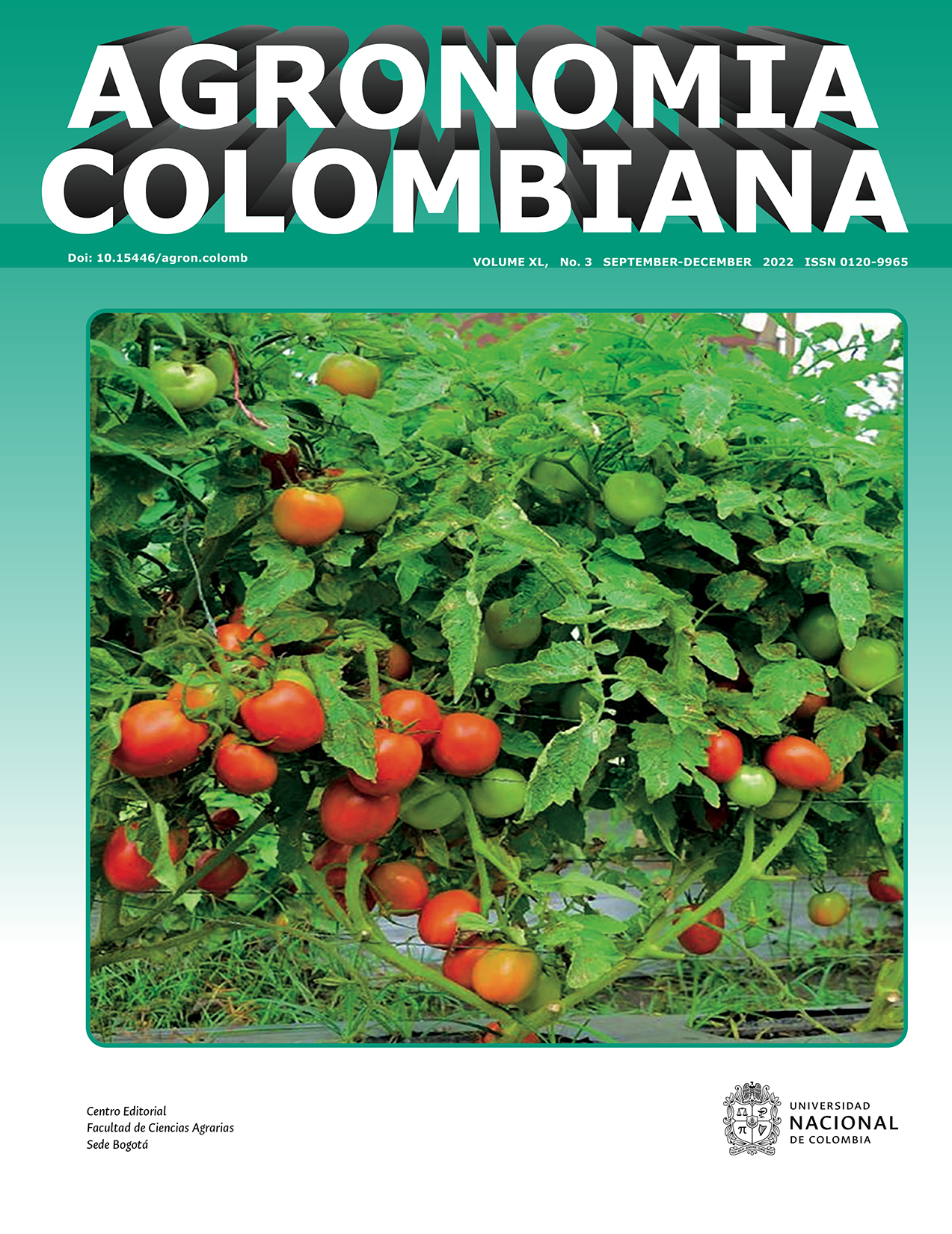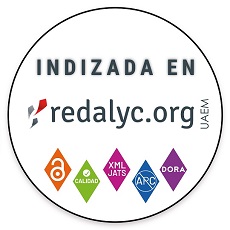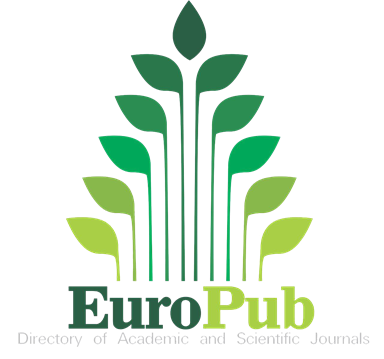Population density of aphids in chrysanthemums grown under photoselective screens
Dinámica poblacional de áfidos en crisantemos cultivados bajo pantallas fotoselectivas
DOI:
https://doi.org/10.15446/agron.colomb.v40n3.103742Keywords:
cut flowers, mechanical barrier, behavioral changes (en)flores de corte, barrera mecánica, cambios de comportamiento (es)
Downloads
The chrysanthemum is one of the main ornamental species in the world. It has great relevance in the market. Aphids are the main pests that affect the chrysanthemum crop and cause various types of damage to this plant. The objective of this study was to evaluate the influence of different cropping systems using photoselective screens on the population density of aphids in cut chrysanthemum. The study was carried out in an experimental area of the Federal Institute of Espírito Santo – Campus Itapina (Brazil) in a randomized complete block design, according to the split-plot scheme over time. The experiment was established in 3 blocks of 12 m in length with plots of 3 m containing different photoselective screens (red, silver, and black) and the control treatment (open field). Repeated evaluations at different times were done at 0, 15, 30, 45, and 60 d. Data were checked for normality and homoscedasticity and submitted to the Tukey’s test (P<0.05) and a non-parametric method of smoothing a dispersion graph with local weight (LOESS regression). Regardless of the color of the photoselective screen, there was a lower incidence of aphids compared to the open field treatment in the chrysanthemum culture with an average reduction of 84%. For the different sampling times, the Tukey test did not show significant differences between the means of aphid incidence in the evaluated period. Black, red, and silver photoselective screens promoted significant reductions in aphid populations in chrysanthemums of the variety Zembla in the environmental conditions of southeastern Brazil.
El crisantemo es una de las principales especies ornamentales en el mundo con gran relevancia en el mercado. Los áfidos son la principal plaga que afecta al crisantemo, causando diferentes daños. El objetivo del presente trabajo fue evaluar la influencia de diferentes sistemas de cultivo bajo diferentes pantallas fotoselectivas sobre la densidad poblacional de áfidos en crisantemo. El estudio se realizó en un área experimental del Instituto Federal de Espírito Santo – Campus Itapina (Brasil); se empleó un diseño en bloques completamente al azar, con un arreglo de parcelas divididas a través del tiempo. El experimento se estableció en 3 bloques de 12 m de largo, con parcelas de 3 m de largo que contenían las diferentes pantallas fotoselectivas (roja, plateada y negra) y el tratamiento testigo (campo abierto). Las evaluaciones repetidas en el tiempo fueron a los 0, 15, 30, 45 y 60 d. Los datos fueron verificados por normalidad y homocedasticidad y sometidos a la prueba de Tukey (P<0.05) y un método no paramétrico de suavizado de un gráfico de dispersión con peso local (regresión LOESS). Independientemente del color de la pantalla fotoselectiva, hubo una menor incidencia de áfidos en comparación con el tratamiento de campo abierto en el cultivo de crisantemo, con una reducción promedio del 84%. Para las diferentes fechas de muestreo, la prueba de Tukey no mostró diferencias significativas entre medias de incidencia de áfidos durante el período evaluado. Las pantallas fotoselectivas negras, rojas y plateadas promovieron reducciones significativas en las poblaciones de áfidos en crisantemos de la variedad Zembla en las condiciones ambientales del sureste de Brasil.
References
Abbasnia, S. K. Z., Sedaghathoor, S., Padasht Dahkaei, M. N., & Hashemabadi, D. (2019). The effect of light variations by photoselective shade nets on pigments, antioxidant capacity, and growth of two ornamental plant species: Marigold (Calendula officinalis L.) and violet (Viola tricolor). Cogent Food & Agriculture, 5(1), Article 1650415. https://doi.org/10.1080/23311932.2019.1650415
Ali, H. B. (2017). Seasonal population abundance of the chrysanthemum aphids (Homoptera, Aphididae) in the middle of Iraq with pictorial key to species. Bulletin of the Iraq Natural History Museum, 14(4), 315–328. https://doi.org/10.26842/binhm.7.2017.14.4.0315
Almeida, J. M., Calaboni, C., & Rodrigues, P. H. V. (2021). Pigments in flower stems of lisianthus under different photoselective shade nets. Ornamental Horticulture, 27(4), 535–543. https://doi.org/10.1590/2447-536X.v27i4.2389
Bastías, R. M., Losciale, P., Chieco, C., & Corelli-Grappadelli, L. (2021). Red and blue netting alters leaf morphological and physiological characteristics in apple trees. Plants, 10(1), 127. https://doi.org/10.3390/plants10010127
Ben-Yakir, D., Hadar, M. D., Offir, Y., Chen, M., & Tregerman, M. (2008). Protecting crops from pests using OptiNet® screens and ChromatiNet® shading nets. Acta Horticulturae, 770, 205–212. https://doi.org/10.17660/ActaHortic.2008.770.24
Bhargavi, S., Hemla, B. N., Chandrashekar, S., Ganapathi, M., & Kantharaj, Y. (2018). Efficacy of bio-stimulants on morphology, flowering and yield of chrysanthemum (Dendranthema grandiflora) cv Kolar local under fan and pad greenhouse. International Journal of Chemical Studies, 6(5), 1831–1833.
Candian, V., Pansa, M. G., Santoro, K., Spadaro, D., Tavella, L., & Tedeschi, R. (2020). Photoselective exclusion netting in apple orchards: effectiveness against pests and impact on beneficial arthropods, fungal diseases and fruit quality. Pest Management Science, 76(1), 179–187. https://doi.org/10.1002/ps.5491
Dhiman, S. R., Gupta, Y. C., Thakur, P.; Kashyap, B., Sharma, M., & Sharma, K. (2018). Effect of different black-out materials on off-season pot mum production of chrysanthemum (Dendranthema grandiflora). Indian Journal of Agricultural Sciences, 88(4), 601–605. DOI: https://doi.org/10.56093/ijas.v88i4.79125
Diaz, B. M., & Fereres, A. (2007). Ultraviolet-blocking materials as a physical barrier to control insect pests and plant pathogens in protected crops. Pest Technology, 1(2), 85–95.
Gulidov, S., & Poehling, H. M. (2013). Control of aphids and whiteflies on brussels sprouts by means of UV-absorbing plastic films. Journal of Plant Diseases and Protection, 120(3), 122–130. https://doi.org/10.1007/BF03356463
Heidemann, J. C., & Barbosa, J. G. (2017). Production and quality of three varieties of chrysanthemum grown in pots with different NPK rates. Ornamental Horticulture, 23(4), 426–431. https://doi.org/10.14295/oh.v23i4.1020
Instituto Brasileiro de Floricultura. (2021, November 5). O mercado de flores no Brasil. https://www.ibraflor.com.br/numeros-setor
Kigathi, R., & Poehling, H. M. (2012). UV‐absorbing films and nets affect the dispersal of western f lower thrips, Frankliniella occidentalis (Thysanoptera: Thripidae). Journal of Applied Entomology, 136(10), 761–771. https://doi.org/10.1111/j.1439-0418.2012.01707.x
Köppen, W. (1936). Das geographische System der Klimate. In W. Köppen, & R. Geiger (Eds.), Handbuch der Klimatologie. Gebruder Borntrager. http://koeppen-geiger.vu-wien.ac.at/pdf/Koppen_1936.pdf
Ngelenzi, M. J., Otieno, O. J., & Mwanarusi, S. (2019). Improving water use efficiency and insect pest exclusion on French bean (Phaseolus vulgaris L.) using different colored agronet covers. Journal of Agricultural Science, 11(3), 159–171. https://doi.org/10.5539/jas.v11n3p159
Nyamukondiwa, C., Weldon, C. W., Chown, S. L., le Roux, P. C., & Terblanche, J. S. (2013). Thermal biology, population fluctuations and implications of temperature extremes for the management of two globally significant insect pests. Journal of Insect Physiology, 59(12), 1199–1211. https://doi.org/10.1016/j.jinsphys.2013.09.004
Parrado Moreno, C. A., Hernández Ricardo, R. E., Velásquez Arredondo, H. I., Lopera Castro, S. H., & Hasenstab, C. (2019). An environmental evaluation of the cut-flower supply chain (Dendranthema grandiflora) through a life cycle assessment. Revista EIA, 16(31), 27–42. https://doi.org/10.24050/reia.v16i31.747
Peel, M. C., Finlayson, B. L., & McMahon, T. A. (2007). Updated world map of the Köppen Geiger climate classification. Hydrology and Earth System Sciences, 11(5), 1633–1644. https://doi.org/10.5194/hess-11-1633-2007
Saicharan, M., Anitha, V., Sridevi, D., & Kameshwari, L. (2019). A brief review on chrysanthemum aphid: Macrosiphoniella sanbornii (Gillette) and its management. International Journal of Current Microbiology and Applied Sciences, 8(4), 278–283. https://doi.org/10.20546/ijcmas.2019.804.031
Sales, R. A., Oliveira, E. C., Buzatto, E., Almeida, R. F., Lima, M. J. A., Berili, S. S., Aguiar, R. L., Lovo, M., Posse, R. P., Santos, J. C., Quartezani, W. Z., Salles, R. A., Siman, F., S., & Siman, F. C. (2021). Photo-selective shading screens as a cover for production of purple lettuce. Scientific Reports, 11(1), Article 14972. https://doi.org/10.1038/s41598-021-94437-5
Santos, H. G., Jacomine, P. K. T., Anjos, L. H. C., Oliveira, V. A., Lumbreras, J. F., Coelho, M. R., Almeida, J. A., Filho, J. C. A., Oliveira, J. B., Cunha, T. J. F. (2018). Sistema brasileiro de classificação de solos (5th ed.). EMBRAPA. https://www.embrapa.br/solos/busca-de-publicacoes/-/publicacao/1094003/sistema-brasileiro-de-classificacao-de-solos
Shahak, Y. (2008). Photo-selective netting for improved performance of horticultural crops. A review of ornamental and vegetable studies carried out in Israel. Acta Horticulturae, 770, 161–168. https://doi.org/10.17660/ActaHortic.2008.770.18
Shahak, Y., Gal, E., Offir, Y., & Ben-Yakir, D. (2008). Photoselective shade netting integrated with greenhouse technologies for improved performance of vegetable and ornamental crops. Acta Horticulturae, 797, 75–80. https://doi.org/10.17660/ActaHortic.2008.797.8
Shahak, Y., Gussakovsky, E. E., Gal, E., & Ganelevin, R. (2004). ColorNets: Crop protection and light-quality manipulation in one technology. Acta Horticulturae, 659, 143–151. https://doi.org/10.17660/ActaHortic.2004.659.17
Shahak, Y. (2014). Photoselective netting: An overview of the concept, research and development and practical implementation in agriculture. Acta Horticulturae, 1015, 155–162. https://doi.org/10.17660/ActaHortic.2014.1015.17
Silva, C. R., Vasconcelos, C. S., Silva, V. J., Sousa, L. B., & Sanches, M. C. (2013). Crescimento de mudas de tomateiro com diferentes telas de sombreamento. Bioscience Journal, 29(S1), 1415–1420.
Singh, R., & Singh, G. (2016). Aphids and their biocontrol. In Omkar (Ed.), Ecofriendly pest management for food security (pp. 63–108). Academic Press. https://doi.org/10.1016/B978-0-12-803265-7.00003-8
Souza, J. N. C., Diniz, J. W. M., Silva, F. A. O. & Almeida, N. D. R. (2020). Economic overview of ornamental flowers and plants in Brazil. Scientific Electronic Archives, 13(5), 96–102. https://doi.org/10.36560/1352020943
Sreedhar, M., Vasudha, A., & Syed khudus. (2020). Insect-pests complex studies on chrysanthemum in Pantnagar region. Journal of Entomology and Zoology Studies, 8(2), 1644–1646.
Thakur, N., Nair, S. A., Kumar, R., Bharathi, T. U., Dhananjaya, M. V., & Venugopalan, R. (2018). Evaluation of chrysanthemum (Dendranthema grandiflora Tzvelev) for desirable horticultural traits. International Journal of Current Microbiology and Applied Sciences, 7(8), 565–574. https://doi.org/10.20546/ijcmas.2018.708.062
Zandonadi, A. S., Maia, C., Barbosa, J. G., Finger, F. L., & Grossi, J. A. S. (2018). Influence of long days on the production of cut chrysanthemum cultivars. Horticultura Brasileira, 36(1), 33–39. https://doi.org/10.1590/S0102-053620180106
How to Cite
APA
ACM
ACS
ABNT
Chicago
Harvard
IEEE
MLA
Turabian
Vancouver
Download Citation
CrossRef Cited-by
1. R Kurniati, Suryawati, D W Utami, H M Siregar, J Mulyono, M Susilowati, I Darwati, W Nurcholis, A Widura, L Sanjaya, Agustiansyah, Supenti, R Syafarina, A. Loch, R.C. Joshi, A. Munawar, M.T. Multazam. (2023). Phenotypic of Varieties Chrysanthemum in Lowland Area Cultivation. BIO Web of Conferences, 69, p.01002. https://doi.org/10.1051/bioconf/20236901002.
Dimensions
PlumX
Article abstract page views
Downloads
License

This work is licensed under a Creative Commons Attribution-NonCommercial-ShareAlike 4.0 International License.
© Centro Editorial de la Facultad de Ciencias Agrarias, Universidad Nacional de Colombia
Reproduction and quotation of material appearing in the journal is authorized provided the following are explicitly indicated: journal name, author(s) name, year, volume, issue and pages of the source. The ideas and observations recorded by the authors are their own and do not necessarily represent the views and policies of the Universidad Nacional de Colombia. Mention of products or commercial firms in the journal does not constitute a recommendation or endorsement on the part of the Universidad Nacional de Colombia; furthermore, the use of such products should comply with the product label recommendations.
The Creative Commons license used by Agronomia Colombiana journal is: Attribution - NonCommercial - ShareAlike (by-nc-sa)

Agronomia Colombiana by Centro Editorial of Facultad de Ciencias Agrarias, Universidad Nacional de Colombia is licensed under a Creative Commons Reconocimiento-NoComercial-CompartirIgual 4.0 Internacional License.
Creado a partir de la obra en http://revistas.unal.edu.co/index.php/agrocol/.




















